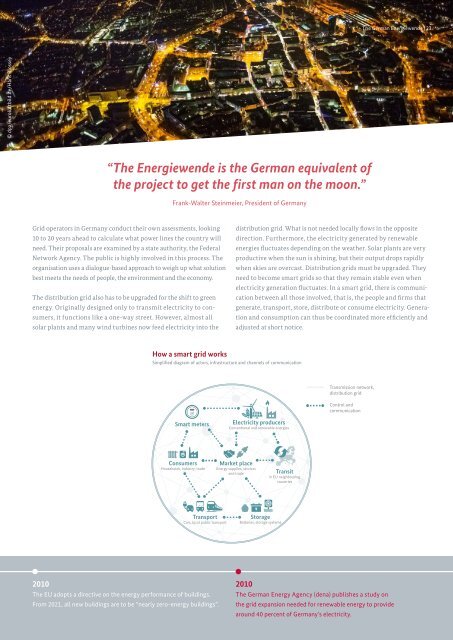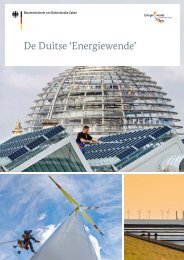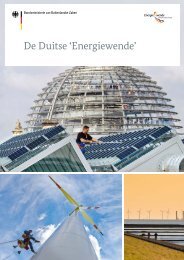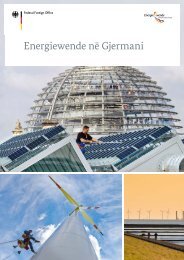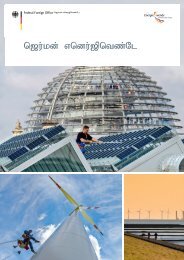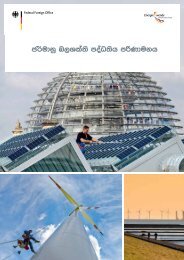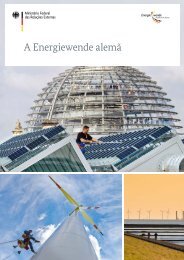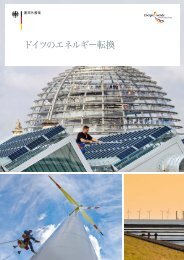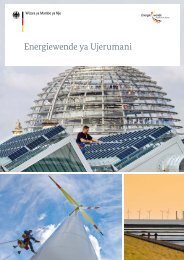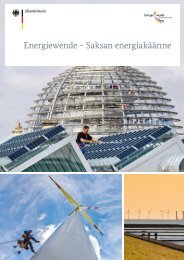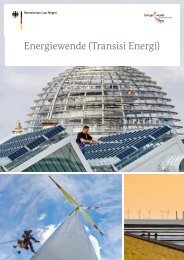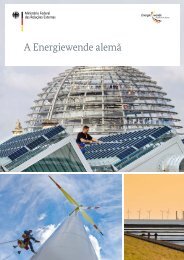The German Energiewende
Create successful ePaper yourself
Turn your PDF publications into a flip-book with our unique Google optimized e-Paper software.
<strong>The</strong> <strong>German</strong> <strong>Energiewende</strong> | 23<br />
© dpa/euroluftbild.de/Hans Blossey<br />
“<strong>The</strong> <strong>Energiewende</strong> is the <strong>German</strong> equivalent of<br />
the project to get the first man on the moon.”<br />
Frank-Walter Steinmeier, President of <strong>German</strong>y<br />
Grid operators in <strong>German</strong>y conduct their own assessments, looking<br />
10 to 20 years ahead to calculate what power lines the country will<br />
need. <strong>The</strong>ir proposals are examined by a state authority, the Federal<br />
Network Agency. <strong>The</strong> public is highly involved in this process. <strong>The</strong><br />
organisation uses a dialogue-based approach to weigh up what solution<br />
best meets the needs of people, the environment and the economy.<br />
<strong>The</strong> distribution grid also has to be upgraded for the shift to green<br />
energy. Originally designed only to transmit electricity to consumers,<br />
it functions like a one-way street. However, almost all<br />
solar plants and many wind turbines now feed electricity into the<br />
distribution grid. What is not needed locally flows in the opposite<br />
direction. Furthermore, the electricity generated by renewable<br />
energies fluctuates depending on the weather. Solar plants are very<br />
productive when the sun is shining, but their output drops rapidly<br />
when skies are overcast. Distribution grids must be upgraded. <strong>The</strong>y<br />
need to become smart grids so that they remain stable even when<br />
electricity generation fluctuates. In a smart grid, there is communication<br />
between all those involved, that is, the people and firms that<br />
generate, transport, store, distribute or consume electricity. Generation<br />
and consumption can thus be coordinated more efficiently and<br />
adjusted at short notice.<br />
How a smart grid works<br />
Simplified diagram of actors, infrastructure and channels of communication<br />
Transmission network,<br />
distribution grid<br />
Control and<br />
communication<br />
Smart meters<br />
Electricity producers<br />
Conventional and renewable energies<br />
Consumers<br />
Households, industry, trade<br />
Market place<br />
Energy supplies, services<br />
and trade<br />
Transit<br />
in EU neighbouring<br />
countries<br />
Transport<br />
Cars, local public transport<br />
Storage<br />
Batteries, storage systems<br />
2010<br />
<strong>The</strong> EU adopts a directive on the energy performance of buildings.<br />
From 2021, all new buildings are to be “nearly zero-energy buildings”.<br />
2010<br />
<strong>The</strong> <strong>German</strong> Energy Agency (dena) publishes a study on<br />
the grid expansion needed for renewable energy to provide<br />
around 40 percent of <strong>German</strong>y’s electricity.


